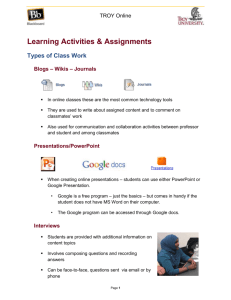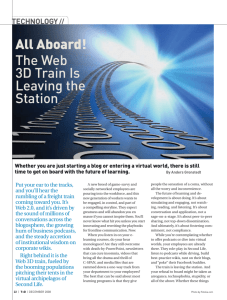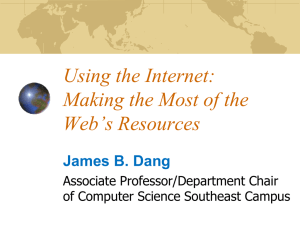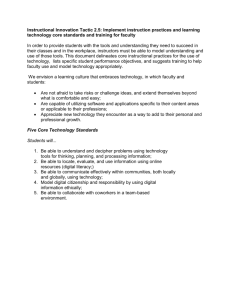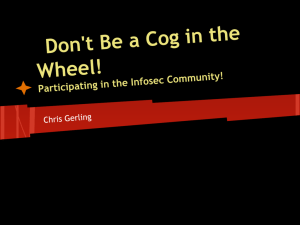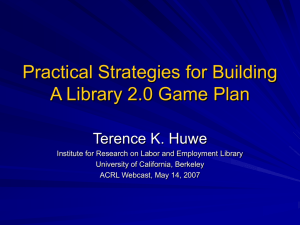Web 2.0 - Trinity Valley School
advertisement
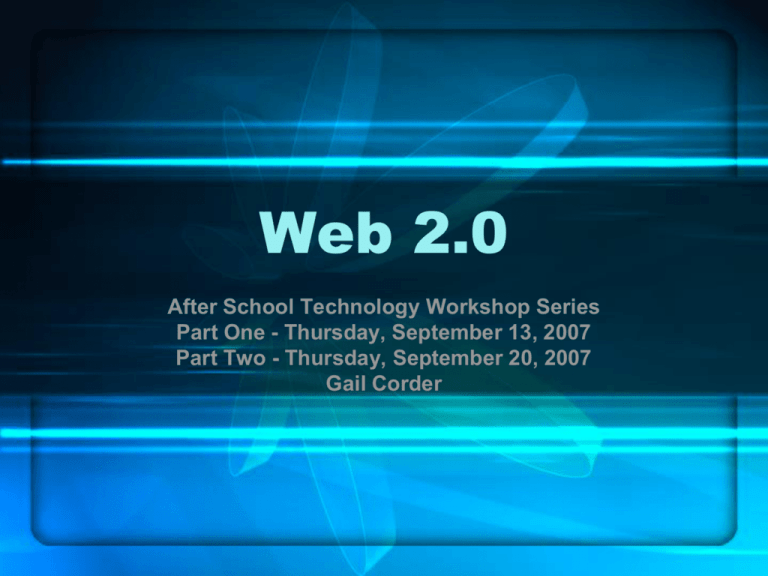
Web 2.0 After School Technology Workshop Series Part One - Thursday, September 13, 2007 Part Two - Thursday, September 20, 2007 Gail Corder What is Web 2.0? • Second generation of the World Wide Web • First web pages were passive. Only those with specialized skills could participate actively. • Web 2.0 applications allow virtually everyone to create and post content online. Examples of Web 2.0 • • • • • Blogs File sharing (Napster) Photo sharing (FlickR) Podcasting Social bookmarking (Del.icio.us) • • • • Wikis Mashups (Netvibes) Google Earth Online Apps (Google Docs) Part One • Blogs • Wikis • Podcasting Part Two • Mashups (NetVibes) • Social Bookmarking (Del.icio.us) • Online Apps (Google Docs) Interactive Maps (Google Earth) Blogs • Short for Web Log • Online journal – posts appear in reverse chronological order • Others may post comments Why Use a Blog? • Archives learning • Supports different learning styles and personalities • Enhances development of expertise in a particular subject • Personal writing space • Can be linked and cross linked to form communities Blogs in the Classroom • Read Blogs (news, economics, music, etc.) – http://awd.cl.uh.edu/blog/ – http://portal.eatonweb.com/ • Subscribe to Blogs – Bloglines (www.bloglines.com) – Mashups (www.netvibes.com) • Write Blogs – www.easyjournal.com – www.livejournal.com – Discussion board on Turnitin.com Podcasting • Came from iPod and broadcasting • Transmission of audio files over the Internet • Can be downloaded to MP3 player, such as iPod, or computer • Don’t have to have an iPod • Can subscribe to regular podcasts – they download automatically to your computer. – RSS Feed/ Push technology – Synched to iPod when connected to computer. • Video podcasting = vodcasting • Podcasting with cell phone = mobcasting Why Use Podcasts? • Good for auditory learners • Speaking practice • Speaking for a different audience • Reinforcement of knowledge • Student motivation • Professional growth Podcasts in Education • Listen to Podcasts (news, economics, music, etc.) – http://epnweb.org – http://recap.ltd.uk/podcasting/index.php • Subscribe to Podcasts – iTunes (www.itunes.com) – iPodder (www.ipodder.com) • Teacher-created/ student-created Podcasts – Odeo Studio (www.odeo.com) – Audacity (http://audacity.sourceforge.net) Wikis • Web page that anyone (with permission) can edit • Creator of wiki has administrative control, can assign others to serve administrative functions • Collaborative in nature Blogs vs wikis “The key difference to keep in mind is that a true wiki is actively collaborative, that is, anyone can edit the document at any point in the document, whether that is to insert a comma, strike a sentence, or add an additional page. Blogs tend to function more like monologues, or pronouncements from the author(s) to which readers may append their own comments without the ability to alter the original blog text.” -Wikipedia Why Use a Wiki? • All the reasons for using a blog plus… – Ideal for any project involving collaboration – More flexibility than a blog (creating online environment as opposed to a journal) Editing a Wiki • Log in (You set up parameters for your students) • Click Edit Page button. • Type your text and format as desired. • Save changes. Examples of wikis Wikipedia – anyone can contribute • Administrators have control over content. Examples of Wikis • WikiTravel – Collaborative travel guide – Phrasebooks – Discussion boards Examples of wikis • WikiHow – How to do almost anything Examples of Wikis • Wikiversity – Initially part of WikiBooks – Main purpose – creation and sharing of learning materials and activities Wikis in Education • Design Patterns • Bernie Dodge, creator of the WebQuest Wikis in the Classroom • Collaborative Writing Project, SUNY Geneseo – Annotated Bibliographies – Dictionaries – Annotated Texts and Articles • Micropedia – AP History Project http://www.ahistoryteacher.com/necc2006/index.html Under Links, click on AP World History Review Project • Consensus Document – DEFRA (UK) Environmental Contract http://wiki.defra.gov.uk/WikiHome/EnvironmentContract/ • Branching Story – Terry the Tennis Ball http://terrythetennisball.wikispaces.com/ • TreeSim – Holocaust Project http://www.ahistoryteacher.com/holocaust/tiki-index.php • Exegesis/Annotated Text – SUNY Geneseo Collaborative Writing Project http://node51.cit.geneseo.edu/WIKKI_TEST/mediawiki/in dex.php/Main_Page – Le Petit Prince http://wiki.trinityvalleyschool.org/index.php/Corderg/ppma in • Dictionary – Spanish 8 – http://dictionary8.pbwiki.com Tree Sim/Ant Farm Read More About It Blogs – http://schoolcomputing.wikia.com/wiki/Blogs Podcasting – http://schoolcomputing.wikia.com/wiki/Podcasts Wikis – http://www.scienceofspectroscopy.info/edit/index. php?title=Using_wiki_in_education Part Two Informational workshop • • • • Mashups (NetVibes) Online Apps (Google Docs) Social Bookmarking (Del.icio.us) Google Earth Caveat: Bandwidth hogs! Productivity Tools Mashups • Make your own customized web portal – www.netvibes.com – Doubles as RSS aggregator. Subscribe to blogs and podcasts on your portal • Google Maps Mashups – – News stories, weather, history, shipwrecks, etc. http://googlemapsmania.blogspot.com/2007/04/n ew-to-google-maps-mania.html • No software to install NetVibes Google Maps Mashups Productivity Tools Online Apps • Portable documents, accessible from anywhere you have an internet connection • Useful for collaboration. Save your changes and share online. • No software to install – Google Docs & Spreadsheets • On Google, pull down More menu – Zoho.com (viewable in your iPhone) Google Docs & Spreadsheets Productivity Tools Del.icio.us • Access your Favorites from anywhere • Share your Favorites with friends and colleagues • See what other people are bookmarking – http://del.icio.us/tag/nasa • No software to install Del.icio.us Instructional Tool Google Earth • View virtually any location on the planet down to street level • Gallery of educational content and tours • Create your own interactive maps, webquests, etc. Google Earth
